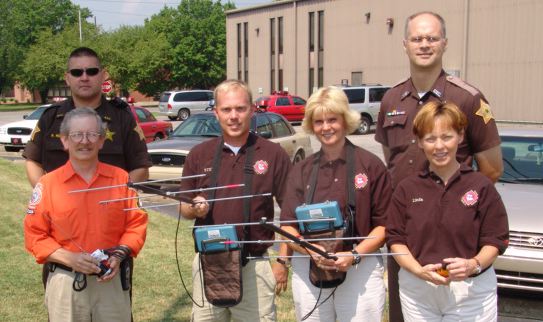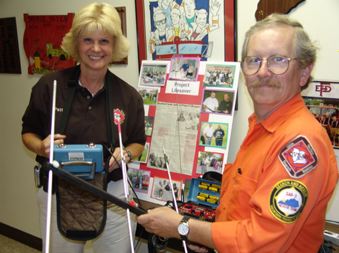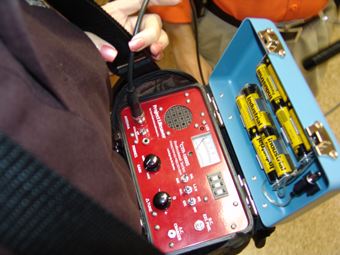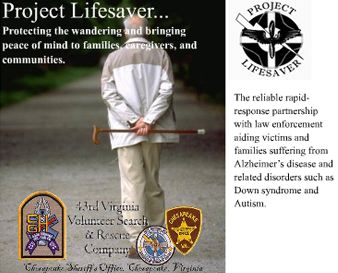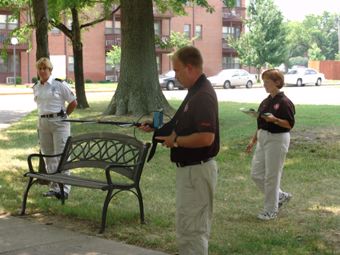|
Project Lifesaver International
is a Charitable, Non-profit 501
(c)(3) Organization
Project Lifesaver is an innovative
rapid response program aiding victims and families suffering from Alzheimer’s
disease and related disorders such as Down Syndrome and Autism.
By forming partnerships with local
law enforcement and public safety organizations, Project Lifesaver deploys
specially trained teams with the most reliable technology available to
quickly locate and return wandering adults and children to their families
and caregivers.

Over 5,000,000 people in the USA
have Alzheimer’s. That number will triple by 2050. Well over 50% of these
people wander and become lost. A lost person with Alzheimer’s or other
dementia represents a critical emergency. They are unaware of their situation,
they do not call out for help and do not respond to people calling out
to them. Nearly half of them will die and many can become injured or fall
victim to predators if they are not located within 24 hours. The number
of people, families and communities experiencing this risk will grow dramatically
in the next few years.
If you are not yet touched in some
way by Alzheimer’s or a related disorder, chances are you will be within
the next several years. You will find it among neighbors, your friends,
co-workers and their families, and perhaps within your own family.
Project Lifesaver, a non-profit
organization, has become internationally recognized as an aggressive and
proven program that saves lives. By the end of 2003, Project Lifesaver
will be operating in over 33 States and at least three countries. It is
an active response to the problem of locating wandering patients before
they fall victim to the elements, accidents, or predators.
How Project Lifesaver Works
Project Lifesaver relies on proven
radio technology and a specially trained search and rescue team. Clients
that are enrolled in the Project Lifesaver program wear a personalized
wristband that emits a tracking signal. When caregivers notify the local
Project Lifesaver agency that the person is missing, a search and rescue
team responds to the wanderer's area and starts searching with the mobile
locater tracking system. Search times have been reduced from hours and
days to minutes. In over 1000 searches, there have been no reported serious
injuries or deaths. Recovery times average less than 30 minutes.
Project Lifesaver is not a registry
program

The Project Lifesaver bracelet
is much more than a passive ID bracelet. It is a one-ounce battery-operated
radio wrist transmitter emitting an automatic tracking signal every second,
24 hours a day. The signal is tracked on the ground or in the air over
several miles. As each bracelet has a unique radio frequency, the Project
Lifesaver search team positively locates and identifies the person who
has wandered away from home or a care facility.
Leading the Way with Rapid Response
and Reliable Equipment
Project Lifesaver is an innovative
solution to the wandering issues surrounding Alzheimer's disease, Prior
to the Project Lifesaver program, there was not an effective search program
that helped to locate missing Alzheimer's patients The only program that
was available to deal with the problem was simply a registry program, whereas
the patient wore a bracelet with a 1-800 number on it. The problem with
that program was the patient had to be found before it could attempt to
get them returned to their families. Many searches across the country often
ended sadly because the person could not be located in time. The difference
in a registry program and Project Lifesaver is we are an active search
participant, we go out and search for the loved one and bring them home.
Project Lifesaver trains, equips and deploys law enforcement and public
safety agencies to rapidly locate wandering people and bring them home.
Project Lifesaver’s radio frequency equipment is the most reliable and
practical technology available in locating the missing and wandering. Our
assessment of Global Positioning System (GPS) equipment is that in an emergency
search situation, it is less durable, the battery has to be changed too
frequently, it is bulky to be worn, can fail in bad weather, and it’s signal
is often undetected indoors, under trees, and in any area that blocks sunlight.
Another major reliability factor is the power source(s). GPS detection
and notification systems for the wandering individual rely on AC power
while their personal GPS equipment relies on batteries that last hours
or 1-2 days. The Project Lifesaver battery provides a continuous signal
for 30-45 days.
Technology is Only Half the Story
Project Lifesaver is about people
and partnerships. The focus is on communities where law enforcement, civic
groups, local business and caregivers join in developing and strengthening
all aspects of the program including rescues, education and especially
fundraising so that families in financial need can have the protection,
and peace of mind.

Project Lifesaver teams are specially
trained, not only in search and rescue and the use of the electronic tracking
equipment, but also in the methods necessary to communicate with a person
who has Alzheimer’s disease or related disorder. Locating the individual
is only part of the mission. The person who is located will be disoriented,
anxious, and untrusting. The Project Lifesaver team knows how to approach
the person, gain their trust and put them at ease for the trip home.
How Project Lifesaver Saves Lives
and Community Resources
In Pittsylvania County, Virginia,
a 45 year-old man suffering from a traumatic brain injury became lost and
disoriented. A deputy sheriff specially trained and equipped by Project
Lifesaver was able to locate the man 1.5 miles from his home within 20
minutes. A traditional search without Project Lifesaver would have normally
involved the time (and expense to the taxpayers) of up to 264 searchers
and 924 man-hours.

In Chatham, Virginia an 80 year-old
woman with Alzheimer’s disease wandered from her home at night. The family
contacted Project Lifesaver upon learning she was missing. Two Sheriff’s
vehicles equipped with Project Lifesaver equipment arrived on the scene
and located the woman laying in a tobacco field. She had wandered into
the field, fell, and could not get up. She was found covered with mud.
Rescuers reported that a person standing up to 10 ft away would not have
noticed that a person was laying there. The helpless woman could have died
if not located by Project Lifesaver.
A 79 year-old man with Alzheimer’s
left his house in Chesapeake, Virginia driving his truck and could not
find his way back home. After searching the neighborhood, a police helicopter
was called in with a Project Lifesaver team and equipment. In just 35
minutes, the helicopter located the man using the signal transmitted from
his bracelet. He was found 14 miles from his home. Before joining Project
Lifesaver, he wandered off and was missing 21/2 days.
Statistics
1,162 Rescues across the Nation
100% Success Rate
Average time of rescue: less than
30 minutes !
History
Established in April 1999 as an
initiative of the 43rd Virginia Search and Rescue Company of the Chesapeake,
Virginia Sheriff’s Office, Project Lifesaver is built on the work of the
Stokes County (NC) Mountain Rescue program which pioneered the use of special
equipment and procedures to locate lost and wandering patients with mental
disorders. Amid the dramatic increase of people with Alzheimer’s, Down
Syndrome, and Autism, Project Lifesaver has become one of the leading organizations
addressing the need to protect these patients and bring comfort to their
families and caregivers.
|


